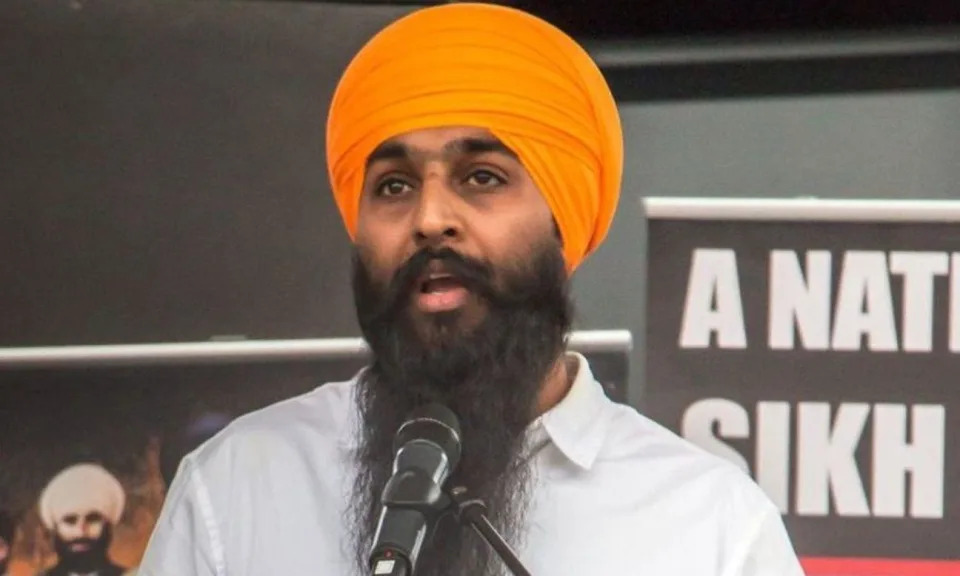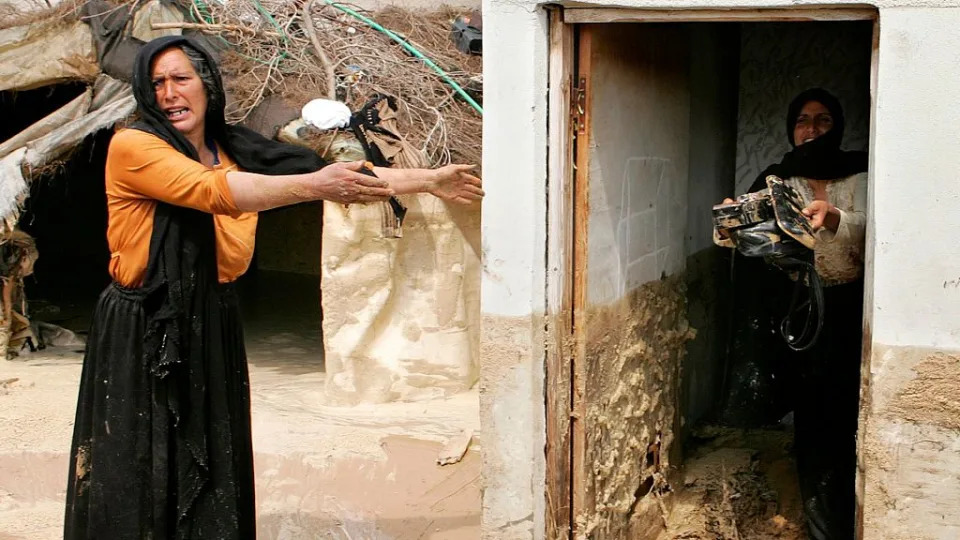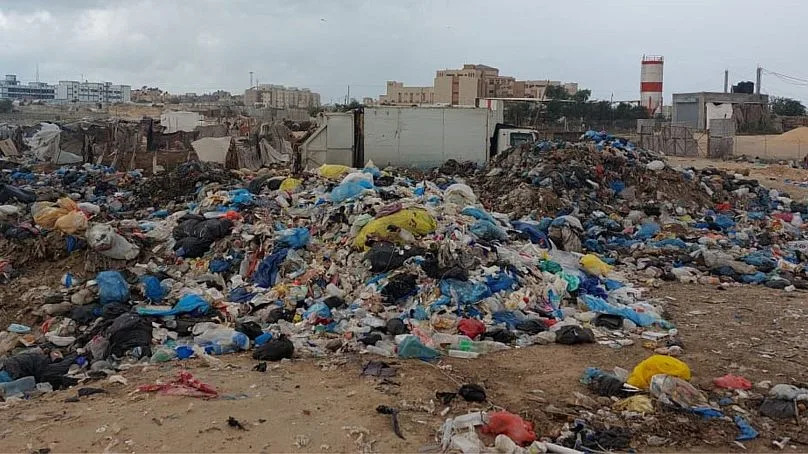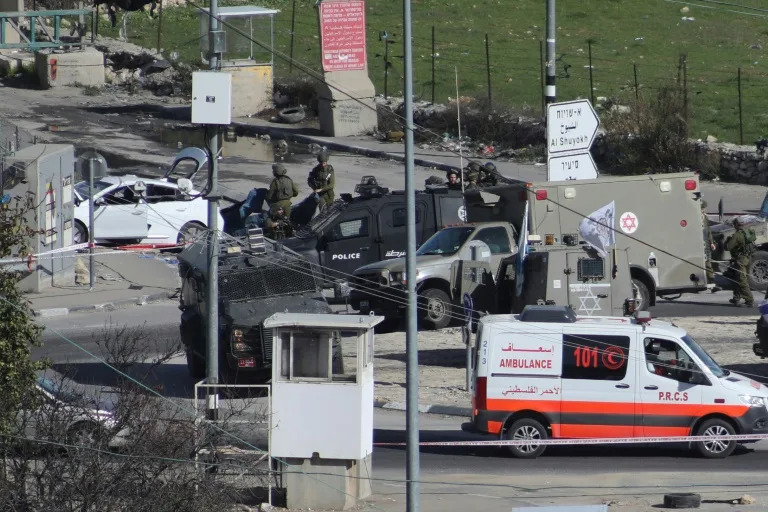The EU is expected to accommodate 30,000 people per year in its joint migration system at any given time - so each country will be assigned a share of that.
LORNE COOK
Updated Wed, December 20, 2023

A Federal Police officer speaks into his radio as he and a colleague track down a group of migrants who have illegally crossed the border from Poland into Germany, while on patrol in a forest near Forst south east of Berlin, Germany, on Oct. 11, 2023. European Union leaders and top officials hailed on Wednesday Dec. 20, 2023 a major breakthrough in talks on new rules to control migration, but critics said the reforms will weaken the rights of asylum-seekers and encourage more morally dubious deals with countries that people leave to get to Europe.
BRUSSELS (AP) — European Union leaders and top officials hailed on Wednesday a major breakthrough in talks on new rules to control migration, but critics said the reforms will weaken the rights of asylum-seekers and encourage more morally dubious deals with countries that people leave to get to Europe.
After overnight talks, visibly exhausted EU lawmakers emerged expressing relief that agreement was found “on the core political elements” of the Pact on Asylum and Migration — a major overhaul of rules that many hope will address the challenges posed by migrant arrivals over the last decade.
“It’s truly a historic day,” said European Parliament President Roberta Metsola, flanked by lawmakers responsible for the key parts of the agreement. With migration likely to be a hot campaign issue ahead of EU elections next June, Metsola said, it was vital to make a breakthrough.
“Let’s not underestimate the risk if we had not reached such a deal,” she told reporters. “This means, hopefully, that member states will feel less inclined to reintroduce internal borders because the influx is being managed.”
The pact was touted as the answer to the EU’s migration woes when it was made public in September 2020. The bloc’s old rules collapsed in 2015 after well over 1 million people arrived in Europe without authorization. Most were fleeing war in Syria or Iraq.
But little progress was made on the pact as the member states bickered over which country should take charge of migrants when they arrive and whether other countries should be obligated to help.
In recent weeks, negotiators bridged differences on rules concerning the screening of migrants arriving without authorization -– facial images and fingerprints will be quickly taken, including from children from the age of 6 -– and the ways that this biometric data can be used.
Agreement was also found on which EU countries should handle asylum applications, the procedures for doing so, and what kinds of mandatory support other countries must provide to nations struggling to cope with migrant arrivals, notably in “crisis situations.”
In a post on X, formerly Twitter, the European Council on Refugees and Exiles – a migrant rights umbrella body – slammed the rules as “Byzantine in their complexity and Orban-esque in their cruelty,” a reference to Hungarian Prime Minister Viktor Orban, who erected razor-wire fences to keep migrants out.
But lawmakers were more sanguine.
Noting that he and fellow negotiators had “not slept a wink in the last couple of days,” Spanish Socialist EU lawmaker Juan Fernando Lopez Aguilar explained that merely agreeing a deal could be seen as a victory, and that “no one can come out of this negotiation entirely happy.”
German Chancellor Olaf Scholz described it as “a very important decision” that will “relieve the burden on countries that are particularly affected — including Germany.”
Spanish Prime Minister Pedro Sánchez told his country’s parliament that the pact “will allow us to have an improved, more humane and better coordinated management of our frontiers and migration flows.”
Dutch caretaker Prime Minister Mark Rutte said the deal improves “control over migration” with “better asylum procedures at the external borders of the EU.” Far-right lawmaker Geert Wilders aims to replace Rutte after sweeping to victory in last month’s elections on an anti-migration platform.
The breakthrough was announced just after the French parliament approved a divisive immigration bill intended to strengthen France’s ability to deport foreigners considered undesirable. The vote prompted a heated debate after the far-right decided to back the measure.
Wednesday’s EU deal is not definitive though. For the entire reform pact to enter force, officials and lawmakers have said, a final agreement on all its 10 parts must be reached by February, and then transcribed into law before the June 6-9 elections.
In recent years, as hope for reforms languished, the EU focused on outsourcing the challenge by offering economic, political and travel incentives to countries that people leave or transit to get to Europe.
A deal with Tunisia, where authorities have been accused of dumping migrants in the desert, was a recent example. Italy has also concluded a bilateral agreement to send people to Albania, but that faces legal challenges. The EU is in talks with Egypt, Iraq, Morocco and Nigeria, among others.
Rights groups warned that Wednesday's agreement will only entrench that kind of thinking.
Eve Geddie, Director of Amnesty International’s European Institutions Office, said that it “will set back European asylum law for decades to come,” and “cause more people to be put into de-facto detention at EU borders, including families with children and people in vulnerable situations.”
“States will be able to simply pay to strengthen external borders, or fund countries outside the EU to prevent people from reaching Europe,” Geddie added.
Oxfam’s EU migration expert Stephanie Pope worried that the pact would encourage “more detention, including of children and families in prison-like centers. They have also slammed the door on those seeking asylum with substandard procedures, fast-tracked deportation and gambled with people’s lives.”
The secretary general of the Caritas Europa charity group, Maria Nyman, said the deal shows that EU countries “prefer to shift their asylum responsibility to non-EU countries, prevent arrivals and speed up return, exposing migrants to human rights violations.”
___
Associated Press writers Kirsten Grieshaber in Berlin, Mike Corder in The Hague and Joseph Wilson in Barcelona contributed to this report.
___
Follow AP’s coverage of migration issues at https://apnews.com/hub/migration
EU reaches ‘landmark’ agreement on asylum reform but deal still faces challenge of ratification
Alex Hardie and Luke McGee, CNN
Wed, December 20, 2023
The European Union has reached a provisional agreement to “thoroughly overhaul” its laws on asylum and migration, a move being hailed as a landmark but which could face challenges when each member state comes to approve it.
The deal covers the political elements of five EU laws that “touch upon all stages of asylum and migration management,” the European Council said in a statement, adding that all five are components of the pact on migration and asylum proposed by the European Commission in 2020.
The five EU laws agreed upon address issues including the screening of irregular migrants, procedures for handling asylum applications, rules on determining which member state is responsible for handling an asylum application, and how to handle crisis situations, according to the European Council statement.
“The new rules, once adopted, will make the European asylum system more effective and will increase the solidarity between member states by enabling to lighten the load on those member states where most migrants arrive,” the statement added.
There have long been complaints that some EU members receive far more migrants than others. Under the proposals, countries not at the border will have to choose between accepting their share of 30,000 asylum applicants or paying at least 20,000 euros ($21,870) per person into an EU fund, Reuters reported.
The agreement was made between the current Spanish presidency of the European Council, which rotates between member states every six months, and the European Parliament.
While the agreement was hailed as historic by Roberta Metsola, president of the European Parliament, a formal deal will still need to be approved by all 27 members of the European Union and ratified by the Parliament, where multiple blocs of parliamentarians oppose the deal.
The European Council noted that the next step of the process will be submitting the provisional agreement to member states for confirmation.
Metsola said in a post on social media that “20th December 2023 will go down in history. The day the EU reached a landmark agreement on a new set of rules to manage migration and asylum.”
Refugee charities have criticized the deal, along with members of the European Parliament.

The Italian island of Lampedusa, close to Africa, has long been a flashpoint. - Zakaria Abdelkafi/AFP/Getty Images
The European Council on Refugees and Exiles, an alliance of 117 NGOs working to protect asylum seekers, said on social media that the deal marked a “dark day for Europe.”
Amnesty International reacted to the agreement on Wednesday, saying that it “will lead to a surge in suffering for asylum seekers, refugees and migrants on every step of their journeys.”
The politics of migration
Migration, particularly the question of how to deal with the large influx of refugees that Europe has seen in recent years, has come to dominate European politics, particularly on the right.
Europe’s geographical location and comparatively friendly record on human rights and support for refugees has made it an attractive destination for those fleeing conflict.
The EU has a vast external border, ranging from the Mediterranean Sea – close to parts of North Africa and the Middle East – to land borders with Russia in the east. Conflicts in these parts of the world over the past couple of decades have naturally led to many people seeking entry to Europe.
The EU faces other unique challenges when it comes to irregular migration, not least because 22 of the 27 EU member states are part of the borderless Schengen area, which makes tracking movement across the bloc somewhat trickier.
The frictionless movement is something that most Europeans don’t want to give up for economic reasons, but a lack of control on migration is the other side of the coin.
Unsurprisingly, this creates ample opportunity for anti-EU politicians to whack Brussels, a tried and tested political strategy for politicians across the bloc. For opposition parties, it means you can hold your government’s feet to the fire on domestic migration policy.
The day before the EU reached its deal on migration, the French parliament passed a controversial immigration bill, which France’s leading far-right politician Marine Le Pen called an “unquestionable ideological victory” for her party.
What's in the new EU deal on migrants?
Reuters Videos
Updated Wed, December 20, 2023
STORY: The European Union agreed on Wednesday (December 20) on new rules designed to share out the cost and work of hosting migrants more evenly and to limit the numbers of people coming in.
The deal is being hailed as a breakthrough after almost a decade of bitter feuds on the issue.
European Commission Vice President Margaritis Schinas.
"...We do have the agreement on this holistic European framework. This is a proud testament to the fact that Europe can deliver solutions on issues that matter to the many, and this is the case on migration."
The New Pact on Migration and Asylum should start taking effect next year.
The bloc aims to spread more evenly the task of caring for arriving refugees and migrants.
The EU is expected to accommodate 30,000 people per year in its joint migration system at any given time - so each country will be assigned a share of that.
It will be calculated on factors including a country’s GDP and population, and the number of irregular migrant border crossings - including sea rescue operations.
Countries unwilling to take in people would instead be able to help their peers through equipment, personnel or cash - at least 20,000 euros per person a year.
The agreement would introduce a new speedy border procedure for those deemed unlikely to win asylum, preventing them from lingering inside the bloc for years.
Their claims would be dealt with in a maximum of 12 weeks and, if rejected, they should be returned to their home countries within a further 12 weeks.
That mechanism would apply to all those deemed dangerous, uncooperative or coming from countries with low asylum recognition rates in the EU like India, Tunisia and Turkey.
EU countries could also apply the speedy procedure to people picked up in the sea trying to get in illegally or filing for asylum at a country's border, rather than in advance.
Before eventually agreeing, Italy and Greece voiced concerns about the workability of the new system, especially as some states refuse to host people.
The southern countries worry about being overwhelmed - especially as complex solidarity schemes take time to kick in.
States further from the bloc’s borders also tend to drag their feet on admitting arrivals.
Another challenge is keeping close tabs on the movement of people once they get inside Europe's free travel zone.
Rights groups said the scheme risked creating overcrowded migration camps on the edges of the EU and the extended detention of minors.
Adding that it focusing on keeping people away rather than helping those in need.
Separately, Poland has refused to take in any of the mainly-Muslim arrivals, though it has given shelter to millions of Ukrainians fleeing Russia's war.
EU agrees 'historic' reform of asylum laws
Marc Burleigh and Anne-Laure Mondesert
Wed, December 20, 2023

The EU reforms mean more border detention centres being set up to screen asylum-seekers (Alessandro Serranò)
The EU on Wednesday agreed to an overhaul of its asylum system that includes more border detention centres and speedier deportations, prompting migrant charities to slam the changes as "dangerous".
But EU governments, officials and MEPs hailed the preliminary accord on the bloc's new pact on asylum and migration as "historic", saying it updated procedures to handle growing irregular arrivals while maintaining respect of human rights.
The legislative reform, reached after lengthy negotiations between EU member countries and bloc lawmakers, has yet to be formally adopted by the European Council and European Parliament.
That is expected to be done before June 2024, when EU elections will decide the next parliament.
Nationalist, anti-immigrant parties are forecast to win more seats in the parliament, reflecting a harder stance among EU voters struggling with a high cost of living.
European Commission chief Ursula von der Leyen welcomed the "historic" agreement on "a fair and pragmatic approach to managing migration".
Many EU countries, including France, Germany, Spain and the Netherlands also hailed the accord.
Italy's interior minister, Matteo Piantedosi, called the agreed reform a "great success", saying frontline countries like his own "no longer feel alone".
But Hungary -- which objects to having to take in irregular migrants or pay countries that do -- rejected the deal in the "strongest possible terms," its foreign minister Peter Szijjarto said.
- Faster screening -
The EU reform includes faster vetting of irregular arrivals, creating border detention centres, accelerated deportation for rejected asylum applicants and a solidarity mechanism to take pressure off southern countries experiencing big inflows.
The overhaul, based on a commission proposal put forward three years ago, keeps the existing principle under which the first EU country an asylum-seeker enters is responsible for their case.
But to help countries experiencing a high number of arrivals -- as is the case with Mediterranean countries Italy, Greece and Malta -- a compulsory solidarity mechanism would be set up.
That would mean a certain number of migrant relocations to other EU countries, or countries that refuse to take in migrants would provide a financial or material contribution to those that do -- something Budapest is fiercely against.
The reform also accelerates the vetting of asylum-seekers so those deemed ineligible can be quickly sent back to their home country or country of transit.
That procedure -- which requires border detention centres being set up -- would apply to irregular migrants coming from countries whose nationals' asylum requests are rejected in more than 80 percent of cases.
Families with young children would have adequate conditions, human rights monitoring would take place and free legal advice provided, MEPs said.
Another point is a proposed "surge response" under which protections for asylum-seekers could be curtailed in times of significant inflows, as happened in 2015-2016 when more than two million asylum-seekers arrived in the EU, many from war-torn Syria.
- Charities' criticism -
Dozens of charities that help migrants criticised the changes.
The deal "will cost more lives at sea," the Sea-Watch ship rescue charity said, arguing that it was "a bow to the right-wing parties of Europe".
Oxfam said the new package is "in many ways... far worse" than the existing system, with one of its migration experts, Stephanie Pope, calling it "a dangerous dismantling of the key principles of human rights and refugee law".
Amnesty International said the "likely outcome is a surge in suffering on every step of a person's journey to seek asylum in the EU", while the Danish Refugee Council complained that "the EU should protect refugees -- not make it harder for them".
Despite these concerns, Greek Prime Minister Kyriakos Mitsotakis announced his "satisfaction" with the effort "to implement a strict but fair immigration policy".
While UNHCR chief Filippo Grandi said the agreement was "a very positive step" and the UN refugee agency "stands ready to advise and support" as it is put into action.
The EU is seeing a rising number of irregular migrant arrivals and asylum requests.
In the first 11 months of this year, the EU border agency Frontex has registered more than 355,000 irregular border crossings into the bloc, an increase of 17 percent over the same period last year.
The number of asylum-seekers this year could top one million, according to the EU Agency for Asylum.
EU Clinches Long-Sought Pact on Contentious Migration Rules
Lyubov Pronina
Wed, December 20, 2023

(Bloomberg) -- The European Union reached an agreement on an overhaul to its rules for tackling immigration crises as it seeks to streamline asylum procedures and boost returns of people who fail to obtain the right to stay in the bloc.
“It’s been a long road to get here. But we made it,” Margaritis Schinas, an EU vice president in charge of migration issues, said Wednesday in a post on X. “Europe is finally delivering on migration.”
The tentative deal between EU member states and the European Parliament, which was clinched after two days and two nights of intense negotiations, still needs to be approved formally by both groups. A number of technical details also need to be worked out in the coming weeks.
Countries facing surges in third-country citizens crossing their borders would be allowed more flexibility on how to handle the arrivals in crisis situations and count on solidarity contributions from other member states such as relocation of asylum seekers and financial help.
German Foreign Minister Annalena Baerbock hailed the agreement, noting that the EU member states for the first time will be required to show solidarity with each other in dealing with migration flows, but said there were some tough compromises.
“Germany couldn’t push through its ambitions concerning the general exception of children and families from border procedures,” she said in a statement. “All the more, we’ll now pay attention that the implementation of the new asylum system will be fair, orderly and in solidarity.”
With over 1 million irregular arrivals registered in the EU since 2015 — including more than 250,000 this year alone — migration is reshaping the bloc’s politics and providing fuel to right-wing parties. Some countries, including Germany, have taken unilateral measures this year to tighten controls at their borders as more people, particularly from the Middle East and Africa, flee violence and poverty.
Read more: Meloni Touts Plan Inspired by Her Vacation to Fix Migrant Crisis
In June, interior ministers agreed on asylum and migration regulations that included a rule that would allow border officials to quickly assess whether applications for entry are unfounded. The new procedure would let governments keep asylum applicants, including families, in locations at the border.
But human rights advocates have been very critical of the proposals being discussed by the EU.
“The deal is nothing but a house of cards incapable of fixing the EU’s broken asylum system,” Stephanie Pope, an EU migration expert at Oxfam, said Monday. “After years of negotiation, we are left with a pact that ushers in increased detention, more pushbacks, and dubious deals with non-EU countries.”
The new border procedure would effectively bar people from applying for asylum, fast-track deportation and put families and children in detention at risk of being returned to home countries where they could face persecution, Oxfam said. The proposal also fails to guarantee that European countries welcome immigrants equally and allows member states pay their way out of solidarity.
©2023 Bloomberg L.P.
EU agrees on major migration deal amid West's anti-immigrant shift
Jenna Moon
Wed, December 20, 2023

Semafor Signals
NEWS
The European Union agreed on a major deal of immigration reform, reducing some of the pressures of migration on its southern members.
The Pact on Migration and Asylum will limit entries into the EU and make it easier for states to process deportations, while spreading some of the burden of receiving new migrants across the bloc.
SIGNALSSemafor Signals: Global insights on today's biggest stories.
Voters and governments shift right on immigrationSources: Semafor, Foreign Policy
Anti-immigration policies have been flourishing in recent months, and even left-wing and center-left parties have sought to reduce migration. The U.S., Australia, and France are all looking to come down hard on immigration, and politicians who have promised to reduce migrant numbers have swept recent elections. The shift partly comes from voters who think established parties ignore their concerns about immigration, driving them to the far-right for whom immigration has always been a talking point, one expert told Foreign Policy. “Mainstream [parties] acted like the issue didn’t exist—they didn’t want to tackle it. That irritated people,” said Jakub Wondreys, a political scientist at the Hannah Arendt Institute for Totalitarianism Studies in Dresden.
But the rich world’s anti-immigrant turn may seem like “an aberration” soonSources: The Economist
There is an “immigration boom” underway in wealthy nations where foreign-born populations are reportedly rising faster than ever before, The Economist noted earlier this year. While part of this is a post-lockdown surge of people with visas who had delayed their moving plans during COVID-19, the primary reason could be the “post-pandemic economy” in rich countries where unemployment is low and demand for labor is high. Some rich governments are trying to attract more students to counter their ageing populations, the Economist wrote, and in countries like the U.S., immigrants bring new enterprises, ideas, and innovation, ultimately generating more tax revenue. “Before long the rich world’s anti-immigrant turn of the late 2010s will seem like an aberration,” The Economist argued.
Journeys for migrants are expensive, and deadlySources: The Wall Street Journal
Across the Atlantic, more than 500,000 people have attempted to traverse Panama’s treacherous Darien Gap crossing this year, which connects South and Central America — doubling the number of people who made the attempt in 2022. Many of the migrants setting out across the region’s dense jungle originate from Venezuela and hope to reach the U.S., which closed two border crossings with Mexico this year in response to 2.5 million encounters with migrants at its southern border. Those with means are taking a different route, paying up to $5,000 to travel by sea from Colombia to Nicaragua, The Wall Street Journal reported. That journey is deadly, and 100 people have gone missing over the last two years.













